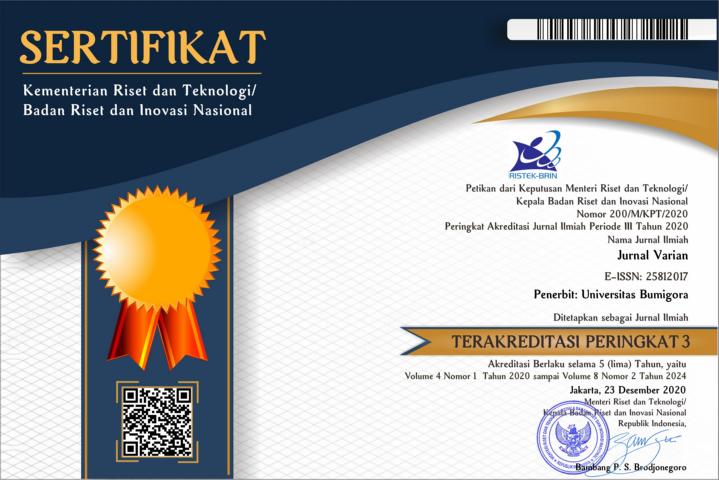Measurement of DEA-Based ICT Development Efficiency Level with Modified CCR Method
DOI:
https://doi.org/10.30812/varian.v6i1.2197Keywords:
DEA-CCR Multiplier Model, DEA-CCR Envelopment Model, Efficiency Level, ModelAbstract
Data Envelopment Analysis (DEA) is the use of non-parametric mathematical programming that is useful for measuring the efficiency of the Decision Making Unit (DMU) of an organization. This study uses the Cooper and Rhodes (CCR) method known as the DEA-CCR multiplier which aims to determine the weight value of each input and output variable of the DMU being evaluated, but it is not sufficient to measure efficiency optimization. To get an efficient value of the weight value of each DMU as a reference to get updated DMU input and output values. So that the DMU efficiency value is obtained which is evaluated. The results of this study show how to modify the Multiplier Model-CCR into the Envelopment Model-CCR. Then displays the efficient level DMU which is evaluated as a result of the weight each DMU gets from the results of processing the LINDO application. Illustrations of changes in input variables and output variables are displayed in the form of tables and figures before and after the changes. The modified DEA-CCR model can also complete DMU super efficiency, effectiveness and productivity.
References
Ben Mabrouk, M., Elmsalmi, M., Aljuaid, A. M., Hachicha, W., and Hammami, S. (2022). Joined efficiency and productivity
evaluation of tunisian commercial seaports using dea-based approaches. Journal of Marine Science and Engineering, 10(5):626.
Borozan, D. (2021). Technical efficiency and productivity change in the european union with undesirable output considered. Energies,
14(16):4937.
Cohn, A. G. and Gotts, N. M. (2020). The egg-yolkrepresentation of regions with indeterminate boundaries. In Geographic objects
with indeterminate boundaries, pages 171–187. CRC Press.
Curtis, P. G., Hanias, M., Kourtis, E., and Kourtis, M. (2020). Data envelopment analysis (dea) and financial ratios: A prostakeholders view of performance measurement for sustainable value creation of the wind energy.
Ewertowska, A., Galan-Mart ´ ´ın, A., Guillen-Gos ´ albez, G., Gavald ´ a, J., and Jim ´ enez, L. (2016). Assessment of the environmental ´
efficiency of the electricity mix of the top european economies via data envelopment analysis. Journal of Cleaner Production,
116:13–22.
Gallardo-Gallardo, E. (2018). The meaning of talent in the world of work. Global Talent Management, pages 33–58.
Grmanova, E. and Ivanov ´ a, E. (2018). Efficiency of banks in slovakia: Measuring by dea models. ´ Journal of International Studies
Vol, 11(1):257–272.
Habibi, A. R. (2019). Performance evaluation of after sale service in automotive industry by data envelopment analysis. Master’s
thesis, Eastern Mediterranean University (EMU)-Dogu Akdeniz ˘ Universitesi (DA ¨ U). ¨
Kohl, S., Schoenfelder, J., Fugener, A., and Brunner, J. O. (2019). The use of data envelopment analysis (dea) in healthcare with a ¨
focus on hospitals. Health care management science, 22(2):245–286.
Kumari, R. (2019). Data envelopment analysis recent applications in banking sector: A survey. International Journal for Research
in Applied Science & Engineering Technology, 7(11):449–456.
Mada, G. S., Dethan, N. K. F., and Maharani, A. E. S. H. (2022). The defuzzification methods comparison of mamdani fuzzy
inference system in predicting tofu production. Jurnal Varian, 5(2):137–148.
Mohmmad Nejad, Z. and Ghaffari-Hadigheh, A. (2018). A novel dea model based on uncertainty theory. Annals of Operations
Research, 264(1):367–389.
Othman, F. M., Mohd-Zamil, N. A., Rasid, S. Z. A., Vakilbashi, A., and Mokhber, M. (2016). Data envelopment analysis: A tool of
measuring efficiency in banking sector. International Journal of Economics and Financial Issues, 6(3):911–916.
Rouyendegh, B. D., Yildizbasi, A., and Yilmaz, I. (2020). Evaluation of retail ındustry performance ability through ıntegrated
ıntuitionistic fuzzy topsis and data envelopment analysis approach. Soft Computing, 24(16):12255–12266.
Sreedevi, R. (2016). Measuring efficiency of private banks us ing ccr model through dea approach. International Journal of Statistics
and Systems, 11(2):167–171.
Tanna, S., Luo, Y., and De Vita, G. (2017). What is the net effect of financial liberalization on bank productivity? a decomposition
analysis of bank total factor productivity growth. Journal of Financial Stability, 30:67–78.
Tavassoli, M., Fathi, A., and Saen, R. F. (2020). Developing a new super-efficiency dea model in the presence of both zero data and
stochastic data: a case study in the iranian airline industry. Benchmarking: An International Journal.
Thomas, L. (2019). Comparative performance of public and private sector banks using data envelopment analysis, india. The Business
and Management Review, 10(5):125–133.
Yang, Y., Wu, D., Xu, M., Yang, M., and Zou, W. (2022). Capital misallocation, technological innovation, and green development
efficiency: Empirical analysis based on china provincial panel data. Environmental Science and Pollution Research, pages 1–14.
Zhu, J. (2019). Annals of operations research (in press).
Zhu, J. (2020). Dea under big data: Data enabled analytics and network data envelopment analysis. Annals of Operations Research,
pages 1–23





















